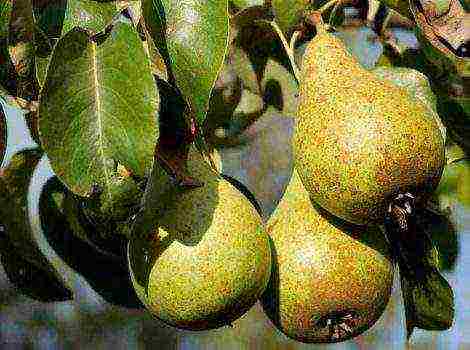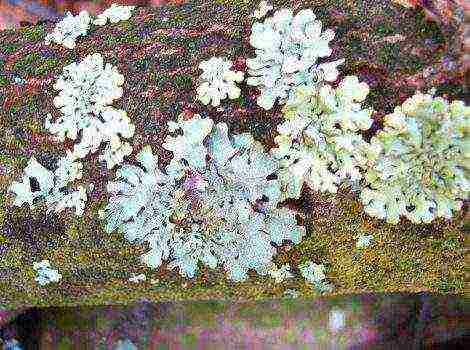Content
Hungarian plum is a varietal group that differs from others in its excellent taste, high yield and long shelf life. The peculiarity of the Hungarian is that prunes can be made only from its fruits. Other types of plum are not suitable for this.
There is no exact data on the origin of the plum. It is believed that it appeared as a hybrid as a result of the cross-pollination of cherry plum and blackthorn in the Caucasus. According to other sources, her homeland is Asia. Who bred the Hungarian plum variety is unknown, but it got its name due to the fact that it was brought to Russia from Hungary in 1900.
It was originally grown on the Black Sea coast. It was an Italian Hungarian. The variety is thermophilic, not resistant to frost, loves high air and soil humidity. But on the other hand, he has the tastiest and sweetest fruits.
Over time, many varieties were bred, adapted to frost and drought, but did not lose quality and retained the ability to make prunes out of them. Now it is grown everywhere - from the shores of the Black Sea to the Leningrad Region. Each region has its own, zoned variety.
Characteristics of plums of the eel group:
- the trees are mostly medium-sized, 3 - 4.5 meters high. The crown is pointed upwards or oval. Shoots are reddish-brown, often located;
- self-fertile, but there are also partially self-fertile varieties;
- high yield;
- bears fruit for the first time 6 - 8 years after planting in a permanent place. There are modern hybrids, the first crop from which can be removed in 3 or 4 years;
- the ripening period of fruits depends on the variety: in mid-season crops are harvested at the end of August, in late varieties - until the end of September.
- drought-resistant;
- the life of the tree is 25 - 30 years.
Description of fruits:
- fruits are large, up to 6 cm in length, 4 - 5 cm in diameter. They have the shape of an elongated ellipse, or ovoid;
- asymmetric plums, one part is convex, the other is flattened and smaller;
- pronounced side seam;
- fruits of a dark color - blue, lilac, purple.
- covered with a waxy coating of a bluish or smoky shade;
- the stone is easily separated, the fruit itself is effortlessly divided into two parts;
- the pulp is elastic, dense. The color depends on the variety;
- sugar content 13 - 15%;
- calorie content 42 kcal per 100 g.
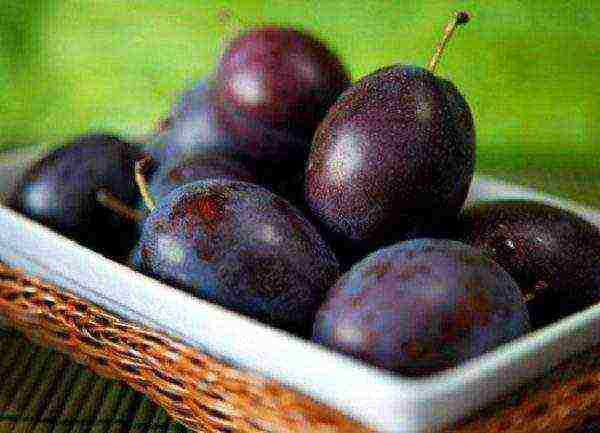
Common varieties of Hungarian
The main differences between the varieties are in winter hardiness, the ability to self-pollinate, the size of the fruits and their taste.
Italian
The height of the tree is 4 meters, the crown is round, spreading, up to 6 meters in diameter. Fruiting from 4 years old, yield from 50 to 70 kg per tree, depending on weather conditions.
Self-fertile, but when cross-pollinated with Algerian or domestic Hungarian, the yield rises. The variety is mid-season, the fruits are ready for harvest at the end of August.
Hungarian Italian does not tolerate frost, in cool summer the yield is lowered. In a dry summer, the ovaries crumble without watering. It is grown in the southern regions, in the Central Black Earth regions, but it freezes in winter. It takes time to recover.
This variety has the largest and sweetest fruits. More suitable for cooking prunes than other varieties.
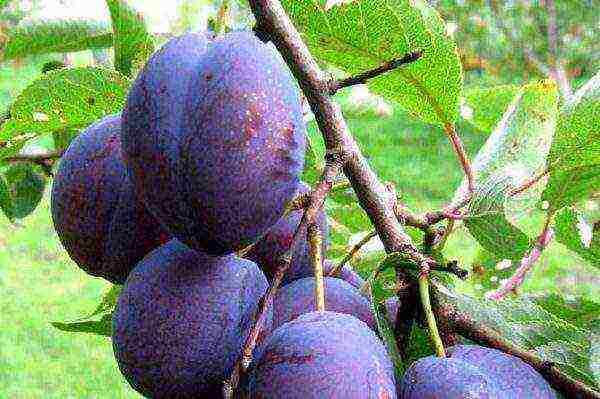
Voronezh
Height 3 meters, paniculate crown with raised branches. Fruiting from 5 years old, yield about 30 kg.
Does not set fruit without cross-pollination.The following varieties are suitable for pollinators: Michurinskaya, Zyuzinskaya, Peaches, Renklod Reform and others. The fruits ripen in September.
Average frost resistance. Suitable for the Central Black Earth regions, but in frosty winters there is a chance of freezing. It recovers quickly.

Michurinskaya
Height 3 - 4 meters. The branches grow at an acute angle. This leads to the fact that in winter, under the weight of sleet or ice, branches break off. Severe damage to the bark can lead to the death of the tree. The same happens with a plentiful harvest, from the severity of the fruit. This can be foreseen and props can be placed under the branches in advance.
The variety is mid-season, appreciated for its juicy fruits with a delicate taste. Plums may not fall for up to 1 month, and when not ripe, they ripen at room temperature.
Low winter hardiness, it is recommended for cultivation in the southern regions or in the south of the Central Black Earth Region.

Belarusian
Height 3.5 meters, round crown, sparse, spreading branches. Fruiting from 3 years old, yield up to 30 kg.
Partially self-fertile. Without cross-pollination, the yield decreases. The fruits can be harvested in the second half of August.Winter hardy, suitable for regions with cold winters. It is resistant to clotterosporium disease.

Moscow
Height is not higher than 3 meters. The crown is dense, round, with drooping branches. Fruiting in 6 - 8 years after planting. Productivity 20 - 35 kg.
Self-fertile, harvest time - early September. Hardy, suitable for growing in central Russia. When freezing, it quickly recovers.Sour plums, suitable for billets.
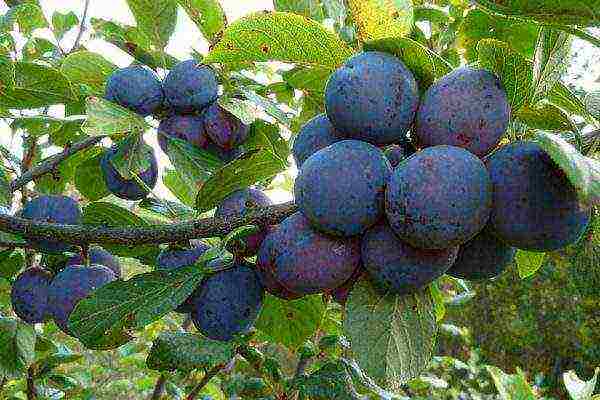
Pulkovskaya
Height 3 - 4 meters, spreading crown, sparse branches. Fruiting from 3 years old. Productivity 25 kg.
Partially self-fertile. To increase the yield, pollination is necessary. For this, early ripening or Winter red is suitable. Ripening late, uneven. The fruits are harvested throughout September.
In rainy weather, the skin on the fruit cracks.The variety is winter-hardy, bred for cultivation in the Leningrad region.
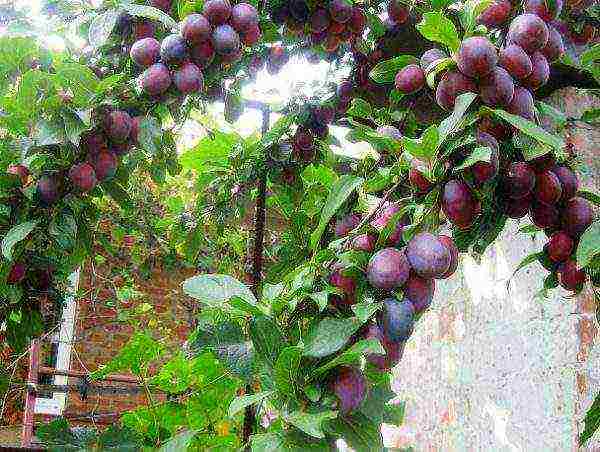
Korneevskaya
Height is 4 meters. The crown is pyramidal or spreading. Fruiting from 3-4 years. Productivity 25 - 30 kg.
Self-fertile. The fruits are ready to be harvested at the end of August. Hardy, drought-resistant. In cold winters, thick bark protects the wood from freezing. Some of the fruit buds freeze out during sudden temperature changes.
The branches are weak, growing at an acute angle. So that they do not break from the weight of the fruits, it is necessary to put supports at the end of July.
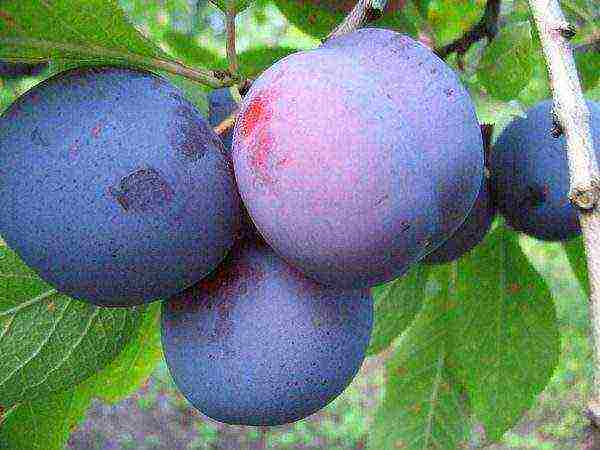
Fruit characteristics
In the above varieties, the shape of the fruit is obovate. They differ in weight, color and taste.
| Variety name | Weight (gr) | Fruit color | Pulp | Taste |
| Italian | 35 | dark, uneven transition from blue to purple, brown tint | bright orange, fleshy | sweet |
| Voronezh | 30-35 | blue - brown | elastic greenish
|
sweet with sourness |
| Michurinskaya | 25-30 | blue - purple | dense, juicy, green with yellowness | gentle |
| Belarusian | 40 | uniform blue | elastic orange | sour sweet |
| Moscow | 20 | transition of red, blue and purple colors | rough, amber color | low-sugar, sour |
| Pulkovskaya | 20-25 | blue, in places reddish-brown spots | light honey color | not pronounced |
| Korneevskaya | 35 | brownish blue | fleshy, honey color | sweet |
Planting rules for seedlings
When to plant seedlings depends on the climate. In the southern regions, it is best to plant at the end of September. Long, cool autumn promotes better survival. In the middle lane and to the north, the best time for disembarkation is April, before bud break. If planted in the fall, then the Hungarian will not take root by the onset of cold weather.
If the place is located in a lowland, it is flooded during floods and rains, it is not suitable for laying a plum garden. Groundwater should be no higher than 1.5 meters from the soil surface.
Planting pits are prepared in 10 days. Their size is 60x60 cm, the depth is the same. A nutritious soil is prepared: the earth is mixed in half with humus, 300 g of superphosphate, 50 g of potassium salt and wood ash, 400 g are added. If planting is carried out in spring, nitrogen must be added, which is necessary for the growth of foliage and the formation of shoots. It is not added in the fall.
Before planting, a strong pole is driven into the bottom of the pit, which will support the young tree for the first two years. When planting, the root collar should be 4 cm above the ground. The distance between the planting holes should be about 4 meters.
Until complete rooting, the earth in the trunk circle is kept moist. Frequent watering can be avoided by putting a layer of mulch in the hole.
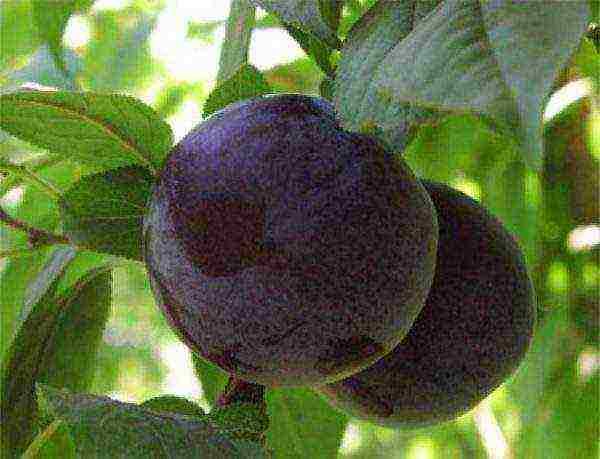
How to take care of a Hungarian woman?
When caring for a plum garden, the following activities are carried out:
- regular watering. Even drought-resistant varieties respond to irrigation with increased yields. Watering is important during flowering and during the period when the fruits are growing;
- top dressing. In the spring, before flowering, organic matter, nitrogen, phosphorus and potassium are introduced. In autumn, after harvest, fertilizers are the same, excluding nitrogen;
- permanent removal of overgrowth;
- weeding and loosening. If the trunk circle is mulched, then this is not necessary;
- installation of supports under the brancheswith many fruits;
- annual regulatory pruning, during which young shoots are removed, thickening the crown, weak, intertwining with each other;
Hungarian plum propagation
Hungarian is propagated in several ways:
- seeds (with bones). Before planting in the ground, the bones must be stratified in the refrigerator from September to March. In March, they are planted in the ground, in the fall on a school. After a year, the seedling is ready for planting in a permanent place;
- vegetatively. Cuttings and shoots are suitable for vegetative propagation. Rooting shoots with a small root is the most effective way. Planted immediately to a permanent place.
- Experienced gardeners propagate the plum vaccination, but this is a more time consuming process.
Diseases and pests
Hungarian plum is more resistant to diseases and pests than other species.
Under unfavorable conditions: thickening of the crown and excessive dampness, the plum can get sick with clasterosporiosis, moniliosis, rust or coccomycosis. These are fungal diseases that are treated with copper medications. A 1% Bordeaux mixture has proven itself well.
In addition to spraying, it is necessary to remove all plant debris from the trunk circle, remove diseased leaves and damaged shoots. They are taken out of the site and burned.
For prevention, every spring, before bud break, trees are treated with a 3% solution of Bordeaux liquid.
Plum is loved by such pests as apple moth, slimy sawfly, shoot moth, hawthorn and others. I treat it with insecticides. At the same time, it is important to observe the timing of the harvest. It is recommended to carry out a double treatment after 10 - 14 days, but on condition that the crop can be harvested only 30 days after treatment.
Prevention against pests consists in treating karbofos twice: during budding and immediately after flowering. In the fall, you need to remove old dried branches, peel off the bark, and remove leaf litter, where pest larvae can hide.
Gardeners reviews
- Gennady: When I was on vacation in the Krasnodar Territory, I ended up in a plum orchard.A large plantation was planted by an Italian Hungarian woman. I have never eaten such delicious plums! I brought the seedling home, and I live in the Kursk region. The first two years of winter were warm, and I also protected the tree - I wrapped it in lutrasil. It has taken root and has grown noticeably. And the third winter was frosty, there was little snow. And what my grief was when in the spring my tree did not bloom a single bud! It's frozen out! Now I adhere to the rule: "Where I was born, there I came in handy." I planted a Hungarian Voronezh in my garden. This year she will be 4 years old. I wait for the harvest year after year.
- Christina: I have a dacha in the Moscow region. The Moscow Hungarian has been making us happy for many years. The fruits are more sour than sweet, only my granddaughter likes the taste. But compotes, preserves and jams are delicious. And this year I want to try to make prunes. Before, I did not know that it was possible, but I tried it with a neighbor and I liked it.
- Ulyana: We have a capricious climate in the Leningrad Region. In other years, little is born. But the plum orchard always pleases - it bears fruit every year, but because! The variety of our plums is called Hungarian Pulkovskaya. Bred specifically for cold climates. We collect all September, enough to eat, and to make preparations.
